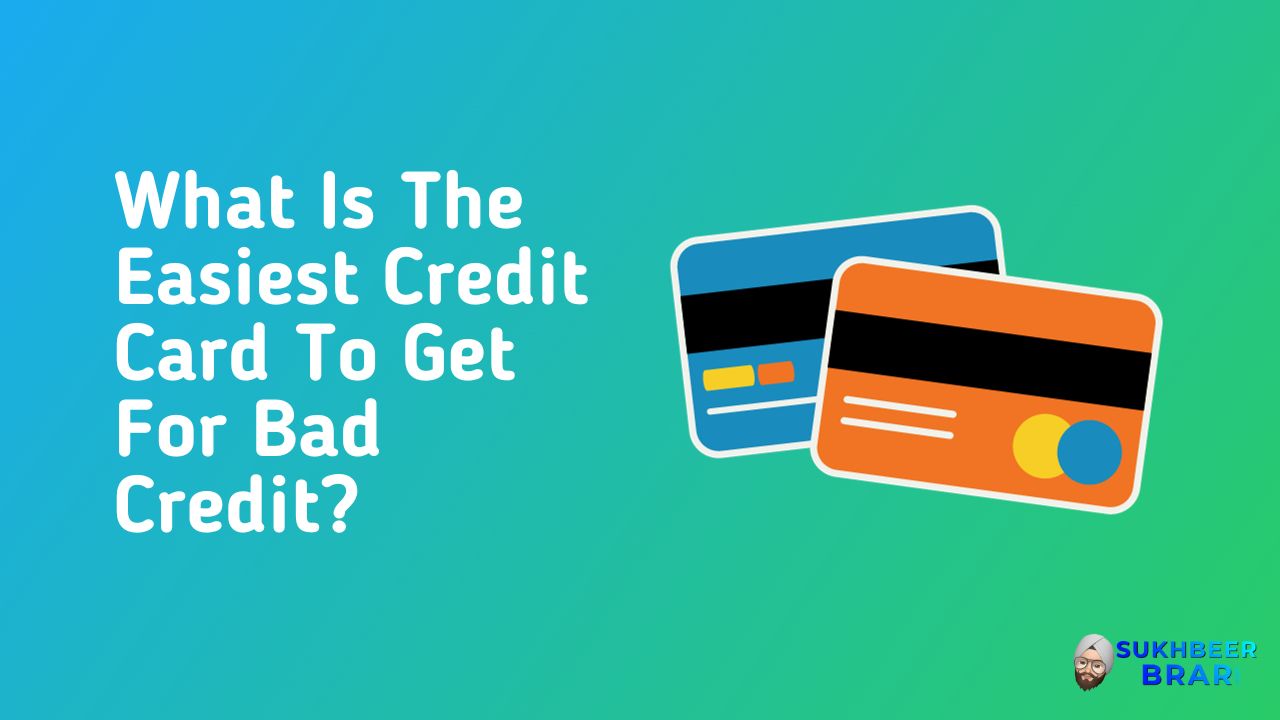A credit score is a number that gives lenders an idea of how likely you are to repay a loan or credit card balance. Credit scores are calculated based on information in your credit report, including your history of paying bills and managing debt. They generally range from 300 to 850.
Having a “bad” credit score under 620 can make it very challenging to get approved for credit cards and loans. Lenders view applicants with poor credit as high-risk, so they are hesitant to extend credit. This can make it difficult to access the financing needed for larger purchases including mortgages and secured loans.
However, there are still options for getting a credit card if you have bad credit. While you may not qualify for top rewards cards, there are credit cards designed for people with poor or limited credit histories. These can help establish or rebuild your credit when used responsibly.
This guide will provide an overview of credit scores, explain credit card basics, and explore the easiest credit cards to get approved for if you have bad credit. With some diligent research and strategic applications, those with poor credit can still find a suitable card and start down the path to improved financial health.
What Is a Bad Credit Score?
A credit score is a number between 300-850 that lenders use to determine your creditworthiness. The most common credit scoring models are FICO® Scores and VantageScore. Scores are calculated based on the information in your credit reports, with factors like payment history and credit utilization carrying the most weight.
Generally, credit scores below 580 are considered poor or bad. This means you will have limited credit options and pay higher interest rates. Here are the basic credit score ranges:
- 800-850: Excellent
- 740-799: Very Good
- 670-739: Good
- 580-669: Fair
- 300-579: Bad
Having a bad credit score negatively impacts your ability to qualify for credit cards, loans, mortgages, rental applications, and more. You may be required to pay large security deposits or denied outright. Low credit scores signal higher risk of default to lenders.
The good news is credit scores are not set in stone. With diligent effort, you can rebuild and improve your score over time. Strategies like paying bills on time, lowering debt, fixing errors on your reports, and using credit responsibly all contribute to credit score increases. Monitoring your score monthly is key to seeing progress. With improved credit, more doors will open for your financial future.
Basics of Credit Cards
Types of Credit Cards
There are several major types of credit cards to be aware of:
- Cash back credit cards – These cards offer a percentage of cash back on purchases, usually 1-2%. The cash back is deposited into your account or applied as a statement credit.
- Travel rewards cards – These cards allow you to earn points or miles on purchases that can be redeemed for travel reservations, upgrades, and more.
- Balance transfer cards – These cards offer an intro 0% APR period, usually 12-18 months, for transferring and paying down a credit card balance.
- Business credit cards – Cards designed for small business use that offer rewards and benefits tailored to businesses.
- Student credit cards – Entry-level cards with low credit limits for those new to credit. May require proof of enrollment.
- Secured credit cards – Require an upfront security deposit that acts as your credit limit. Help rebuild credit.
Secured vs. Unsecured Credit Cards
- Secured credit cards require an upfront refundable deposit, usually $200 or more, that acts as your credit limit. They are designed for bad credit applicants.
- Unsecured credit cards do not require a deposit. Your credit limit is set based on factors like your credit score. Easier to qualify for with good credit.
Key Terminology
- APR – Annual Percentage Rate, the interest rate charged on balances.
- Credit limit – Maximum amount that can be charged on the card.
- Minimum payment – Lowest payment option per month. Paying this results in interest charges.
- Grace period – Interest-free period between statement date and payment due date.
- Balance transfer – Moving debt from one card to a new card, often at a promotional 0% APR.
- Cash advance – Using credit card to obtain cash, often at a higher interest rate.
- Annual fee – Optional or mandatory yearly charge to maintain the credit card account.
Factors That Affect Your Eligibility
Your eligibility for a credit card depends on several key factors related to your financial profile. Even if you have bad credit, you may still be approved by demonstrating other signs of financial responsibility.
Credit History
Your credit reports and score are some of the most important criteria. Issuers will evaluate your history of making payments, your balances, collection accounts, bankruptcies or other public records. Having a poor score doesn’t necessarily disqualify you, but it makes approval more difficult.
Income and Employment
Lenders want to see you have enough steady income to make your minimum payments. They may ask for pay stubs, tax returns or other documentation. Having a full-time job for at least a year improves your chances. If you’re unemployed or have inconsistent income, your application may be denied.
Debt-to-Income Ratio
Your debt-to-income ratio compares your monthly debt payments to your gross monthly income. A high ratio means you have less available income to make credit card payments. Many issuers look for a ratio below 30-50%. You can improve this by paying down debts before applying.
Address History
Lenders prefer at least 1-2 years of residence history at your current address. Having a stable address helps demonstrate financial responsibility. If you moved recently or lack established residency, it can negatively impact your application. Providing documentation about your place of residence can offset these concerns.
Options for People with Bad Credit
People with poor or limited credit histories have several options for getting a credit card, despite the challenges. Here are some of the main options to consider:
Secured Credit Cards
Secured cards require a cash deposit that acts as collateral on the account. The deposit amount usually becomes your credit limit. Secured cards are one of the easiest options for bad credit since they are designed for building or rebuilding credit.
Retail Store Credit Cards
Store cards with flexible eligibility requirements may approve applicants with bad credit more readily than traditional lenders. Store cards can help establish positive payment history. Downsides are higher APRs and low credit limits.
Credit-Builder Loans
Credit-builder loans don’t actually provide borrowed money upfront. You make monthly payments, which are held in a savings account. Once paid in full, you get the money you “borrowed” plus interest. Credit-builder loans can demonstrate responsible usage.
Becoming an Authorized User
You can request to become an authorized user on someone else’s credit card. Their positive account history can then start to strengthen your credit, if they add you as a user responsibly. This works best when added to a longstanding account of a trustworthy friend or relative.
The Easiest Credit Cards to Get for Bad Credit
When you have bad credit, it can be challenging to get approved for a credit card. However, there are some cards that are easier to qualify for than others. Here are the top 3 easiest credit cards to get with bad credit.
Secured Capital One Platinum Card
The Capital One Platinum Secured card is one of the easiest secured cards to get approved for. Here’s what makes it a top choice:
- No credit check required for approval
- Can get approved with a security deposit as low as $49
- Reports to all 3 major credit bureaus to help build credit
Surge Mastercard
The Surge Mastercard by Celtic Bank is an unsecured card that is easier to qualify for than traditional unsecured cards. Key features include:
- Pre-qualification available with no impact to credit score
- Monthly payments as low as $10 during first 6 months
- Credit limits starting at $200 with opportunity to increase
OpenSky Secured Visa Card
OpenSky offers an easy-to-get secured card with guaranteed approval. Benefits include:
- No credit check or security deposit required
- Can qualify without a social security number
- On-time payments reported to build your credit
These three cards are ideal options for rebuilding or establishing credit. Their relatively easy approval requirements make them accessible even with bad credit scores.
How to Apply for a Credit Card with Bad Credit
Gathering the necessary documentation and information is an important first step when applying for any credit card. Here are some tips on what you’ll need:
- Identification Documents – You’ll need photo ID, Social Security card, and proof of your current address.
- Income Verification – Pay stubs, tax returns, or bank statements showing regular income. Some issuers may require this even if you don’t have a job.
- List of Assets – Lenders may want to see what assets you have, so prepare a list of property, investments, etc.
- Budget Overview – Document your monthly income, expenses, debts, and credit obligations. This helps issuers assess your ability to make payments.
Once you’ve gathered documents, take time to thoroughly compare potential cards and issuers. Look at fees, credit limits, rewards programs, customer service reputation, and other features. Make sure you understand all the terms and conditions.
When you’re ready, you can apply online, in person at a bank, or over the phone. Be prepared to provide identification, income, budget, and asset info. The issuer will likely check your credit report and score.
After applying, give it some time for processing – could take a week or more. Call issuer if you don’t hear back. If approved, you’ll receive card and agreement in the mail. Read agreement carefully and activate card. If denied, issuer should explain why. You may need to improve score or reapply later.
Managing Your New Credit Card Responsibly
Getting approved for a credit card when you have bad credit is an important first step, but managing the account responsibly is essential for rebuilding your credit. Here are some tips:
Understand the Terms and Conditions
Carefully review the terms and conditions for your new card so you understand the interest rate, fees, credit limit, billing cycle, payment due date, and other key details. This will help avoid surprises or accidental misuse of the card.
Make On-Time Payments
One of the biggest factors in your credit score is your track record of on-time payments. Set up autopay or calendar reminders for your due date so you never miss a payment. Pay at least the minimum (though more is better) by the due date every month.
Keep Balances Low
Ideally, you should pay off your balance in full each month. But avoid maxing out your card or carrying a high balance, as the credit utilization ratio has a major influence on your score. Try to keep your balance below 30% of the limit.
Following responsible credit card habits will demonstrate you can use credit wisely over time. This will help improve your credit score so you can eventually qualify for better credit products with lower interest rates.
FAQs about Getting a Credit Card with Bad Credit
Can I Get a Credit Card with No Credit History?
Yes, it is possible to get a credit card if you have no credit history. Some credit card companies offer cards specifically for people who are new to credit. These cards tend to have lower credit limits and fewer perks, but can help you start building your credit.
Options like secured credit cards allow you to put down a refundable deposit that acts as your credit limit. This gives the card issuer some security since you have no established credit. Using a secured card responsibly over time can demonstrate your creditworthiness.
What Are the Downsides of Secured Credit Cards?
The main downsides of secured credit cards are the deposit required upfront, lower credit limits, and lack of rewards compared to traditional credit cards. The deposit often equals your credit limit, tying up funds until you eventually upgrade to an unsecured card. Limits are usually under $500 for secured cards. And there are rarely cashback, points, or travel perks offered.
How Long Does It Take to Improve a Bad Credit Score?
It can take several months to see a significant improvement in your credit score if you use credit responsibly. Pay all bills on time, keep balances low, and avoid applying for new credit unnecessarily. After 6 months of responsible habits, you may see your score start to climb. It typically takes at least 12 months of dedication to see a bad score improve substantially.
Can I Upgrade to an Unsecured Card Later?
Many secured card issuers do allow upgrading to an unsecured card over time, contingent on responsible use of the secured card. After making on-time payments for around 7-12 months, you can request an upgrade and graduate to an unsecured card. This returns your security deposit and gives you a normal credit limit based on your improved score.
Will Applying for Multiple Cards Hurt My Credit?
Every credit application triggers a hard inquiry on your credit report, which can negatively impact your score temporarily. Applying for too many new accounts in a short period alarms creditors and indicates higher risk. Therefore, it’s best to be selective and only apply to 1-2 recommended cards for bad credit. Too many applications at once hurts your approval odds.
Conclusion
Getting a credit card when you have bad credit can seem daunting, but this guide has shown that there are options available. The key is finding a card that is achievable to get approved for based on your credit score and financial situation.
Secured credit cards are often the easiest type of card to get approved for when your credit is poor. They allow you to put down a refundable deposit as collateral and use the card responsibly to start rebuilding your credit. Store credit cards, prepaid cards, and credit-builder loans are other options to consider on your path to credit recovery.
Whichever card you get approved for, be sure to manage it responsibly by making all minimum payments on time each month and keeping utilization low. This will help boost your credit score over time so you can eventually qualify for an unsecured card and continue growing your credit.
With some patience and diligent effort, a bad credit score doesn’t have to hold you back forever. Getting your first card, or next card, can put you on the road to financial recovery. Stay focused on improving your credit and you’ll be able to qualify for better terms in the future. The potential rewards are well worth the initial challenge of getting approved.



